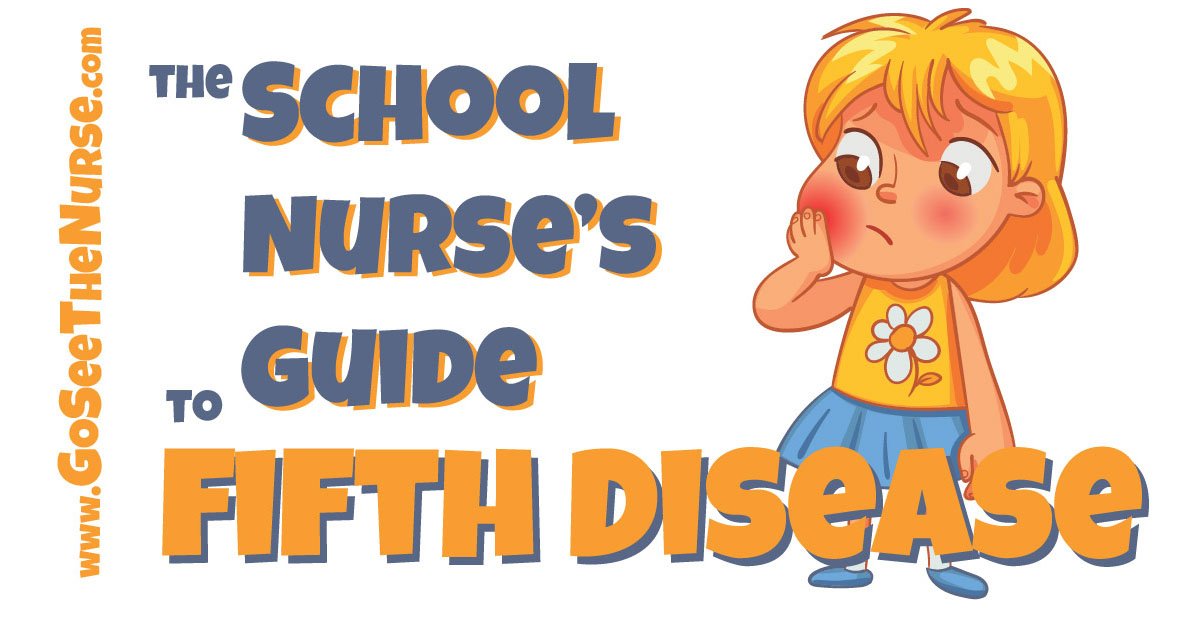
I am TOTALLY getting spring fever! I know it’s only the middle of January, but I don’t care…I’m already doing some gardening preparations. However, if you’ve noticed a few children with “spring fever” this early in the year, it’s likely viral…and they are sick…literally. We’ve already talked about the flu and HFMD. But we haven’t talked about Fifth Disease (Slapped-Cheek Syndrome). And, the winter and spring months are when this illness is most prevalent. Welcome spring fever…
What is Fifth Disease?
Fifth Disease is caused by a virus, the Parvovirus B19. No, this virus is not a virus that can be caught from an animal. That is a different virus called Canine Parvovirus (parvo). We humans are susceptible to the Parvovirus B19. You may also see this virus referred to as “Erythema Infectiosum.” Beyond that, we school nurses are more interested in how to identify Fifth Disease and how to prevent it. Let’s get to that information…
What are the signs and symptoms of Fifth Disease?
Commonly, you’ll see a child come into your office who is not feeling well. They may have a headache, fever, and a sore throat — nothing especially out of the ordinary. And, no, neither would I suspect Fifth Disease as being the culprit for the child feeling “under the weather.” After all, we medical folks usually (and unknowingly) practice under the (unofficial) guidelines of Occam’s Razor. We may treat by offering rest, OTCs (with parental permission), and even exclusion from school in order to promote resolution as well as prevention of spreading “it” to the other students (after all, flu-like symptoms are a sure way to get a few days at home).
A hallmark symptom of Fifth Disease is the tell-tale red rash area on the cheeks that shows up a week or two (or three) later. This common symptom of those infected by Parvovirus B19 is a red rash on the cheeks which has given Fifth Disease the nickname “Slapped-Cheek Syndrome.” This rash may come-and-go and become most noticeable when the child is exposed to a warm environment or after coming into the warmer school building after a cold and active recess period. But, don’t all the children have rosy red cheeks after a cold recess? Sure they do.
The “kicker” is the time at which you are seeing these red cheeks. Unfortunately (and fortunately), the contagious period lasts all the way up to the point when the rash appears.
The incubation period last for about 4-14 days. Personally, I believe that knowing incubation periods is important. It helps identify possible “locations” of exposure if the symptoms of any illness is seen early in the school year, after breaks, or just anytime.
How is Fifth Disease spread?
My son, a super-smart and super-good-lookin’ kid (takes after his mamma) of 11 years old has often received ridicule from his classmates due to his germ-aware nature. No, we don’t wear shoes in our house. Yes, we wash our hands when we enter our home after touching the “outside world.” No, we don’t share food or drinks from another person outside of our family nucleus. He often gets called a “germaphobe” by his classmates, who think he is not normal when he will not eat or drink after anyone else. The kid will not eat chips out of a bag that others have had their hands in. I just tell him to smile and wave…and wait…they will learn their lesson.
Fifth Disease is spread by the good, old-fashioned way of someone getting someone else’s slobber / mucus on their mucus membranes (respiratory (droplet) route – saliva, sputum, or nasal mucus).
- Coughing or sneezing in another’s general direction. Though the droplets will not stay suspended in the air (less than 3 feet and depending on the force of the “sputum discharge”).
- Touching your face. It’s possible to pick up the cootie (a.k.a. the virus, for you nurses who like those “official” terms) from a surface and rub it into your eye, install the virus during a nose-picking session, or set it in your mouth during back-of-the-hand mouth wiping or trying to dig some lunch out of your tooth with your fingernail (just keeping it real).
- EATING AFTER SOMEONE! Children…please…please…PLEASE…Don’t share utensils or take a bite of someone else’s food or sip of someone else’s drink. And trust me, “wiping it off” ain’t gonna work (it will just smear the virus along a larger surface area). And, yes…seemingly dry hands reaching into a Takis bag for a “handful” is an excellent way to spread the virus (what kid doesn’t lick those red-tinted fingers after a few Takis?).
- It is rare, but Fifth Disease can be transmitted through exposure to blood.
A person is most contagious during the “it’s just a fever” or “it’s just a cold” periods and before the rash appears. Because once the rash appears, the person is no longer contagious.
What can the school nurse do to control the spread of Fifth Disease?
Just keep doing what you are doing. Work with your building’s custodian and ensure that the surfaces that are touched often by your school’s population are sanitized frequently. Promote handwashing BEFORE and after going to the bathroom. And make sure there are plenty of tissues for the seasonal membership to the coughing, sneezing, and drippy-nose clubs.
If you have a child with the red cheek rashes and suspect / diagnosed Fifth Disease, consider the not-yet-symptomatic siblings and friends of the child.
- Johnny has the later findings of the illness, and his sister arrived with a headache and low-grade fever to your office.
- Paul has findings that suggest Fifth Disease and has a girlfriend with whom “smooching” occurs.
- Suzie in Ms. Johnson’s class has been out of school for few days and has a doctor’s note for the missed days confirming Fifth Disease (and the parent hasn’t notified the school up to now). And, your health-office log shows 5 children over the past 4-5 days with cold and flu-like symptoms.
To exclude or not?
This is a tricky one. I will try to answer this with three scenarios:
- Little Julie has a fever of 102.4 degrees. She is feeling very poorly with a headache and sore throat. There are no other symptoms of Fifth Disease. WHO CARES! Send that child home. She’s got something, right? Exclude.
- Little Johnny does not have the familiar red, rashy cheeks, but does have other, early symptoms of Fifth Disease, including a diagnosis of Fifth Disease from his pediatrician. Give a one-way ticket home for Little Johnny. Exclude.
- Little Jordan has Sickle Cell disease. Parvovirus B19 can cause transient anemia in infected children. Likely, a child that is healthy in general will not be notably affected by the illness. However, a child who already has a condition like Sickle Cell Anemia will need closer observation and care beyond that which is available in a school house. Exclude.
- Little Ricky is immunocompromised. Not only is this child at risk for increased complications from the illness, this child may shed larger amounts of the virus. And, unlike money…more ain’t always better. Exclude.
- Little Kingston has rosy red cheeks. He had been home for a few days with an illness the mother reported as being the flu (with or without an actual physician diagnosis). There are no other symptoms per se’. Exclude? Maybe or maybe not? This is when good nursing judgment comes into place. Does the child feel well enough to participate in the day’s activities? Is the child emotionally mature enough to control his secretions?
Question: Is there an expecting mother in the home where the child resides?
Question: Is there a pregnant teacher/para/faculty who teaches a child with Fifth Disease?
If you have a child whom you suspect has Fifth Disease, and there is a pregnant woman who has close contact with the child, be sure to educate the teacher / guardian regarding the safety of the mother and the baby. The virus can make it hard for the growing baby to make red blood cells.
Sixty-five percent of pregnant women in North America have evidence of past infection with Parvovirus B19. And, the good thing is (yes, there is a good thing): once you have made it through the infection process, you become immune to Fifth Disease and won’t become infected again (usually). Now, with that being said, many of those who are immune to Fifth Disease don’t even know they are immune because in “20% to 30% of adults, the infection is asymptomatic.”
But, pregnant mothers may not know the risk. And, if they have a child home sick with Fifth Disease, it would be very good to offer some teaching and suggest they seek the guidance of their obstetrician. If the child is in (or has been in) a classroom with a pregnant teacher, this information should be offered in order for the mother-to-be to follow up with their obstetrician.

Don’t miss the nail! Start getting (non-spammy) updates from Nurse Kevin!
Your information is kept private! Here’s my Privacy Statement.
Nurse Kevin





Thank you for a good article. I fight this issue with the teachers all the time!
It’s hard sometimes when we work with so many different personalities that are not “medical” in their profession. Growing up in the South, I’ve worked with all kinds of folks that use all kinds of remedies to “fix” problems and to “diagnosis” problems. I’ve had folks tell me that they don’t want to immunize their child…not because they believe that immunizations are “bad.” But, because they want their child’s “immune system to be real strong.” So…with teachers…I hear and I listen (they are mammas and daddies and some are long-time veterans of their profession having taught 1000s of kids and seen as many ailments). But, in the end, we school nurses are the one who makes the clinical call…and…well…that’s how it goes. The goal is ultimately to avoid the “why questions.”